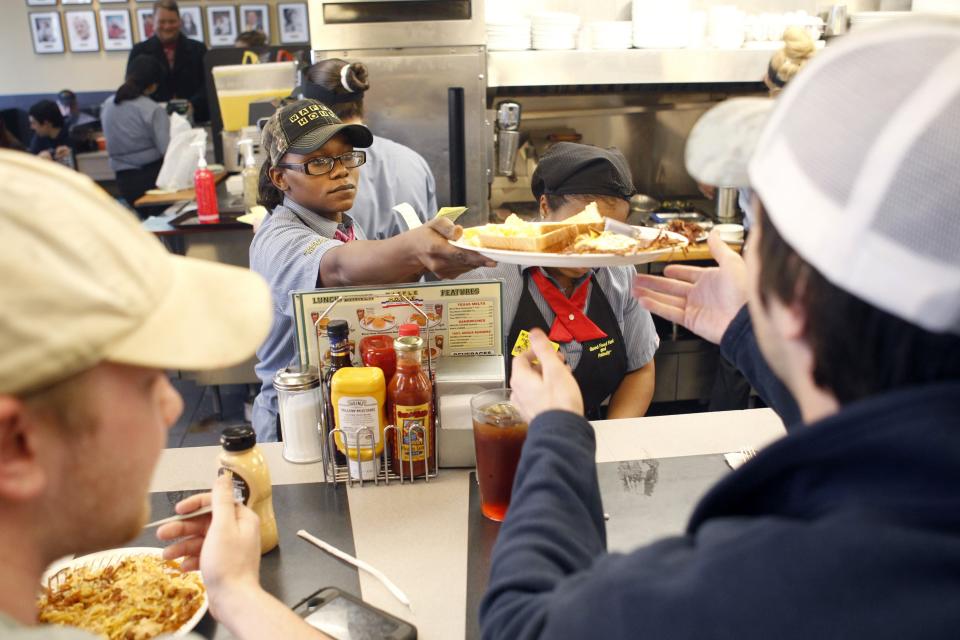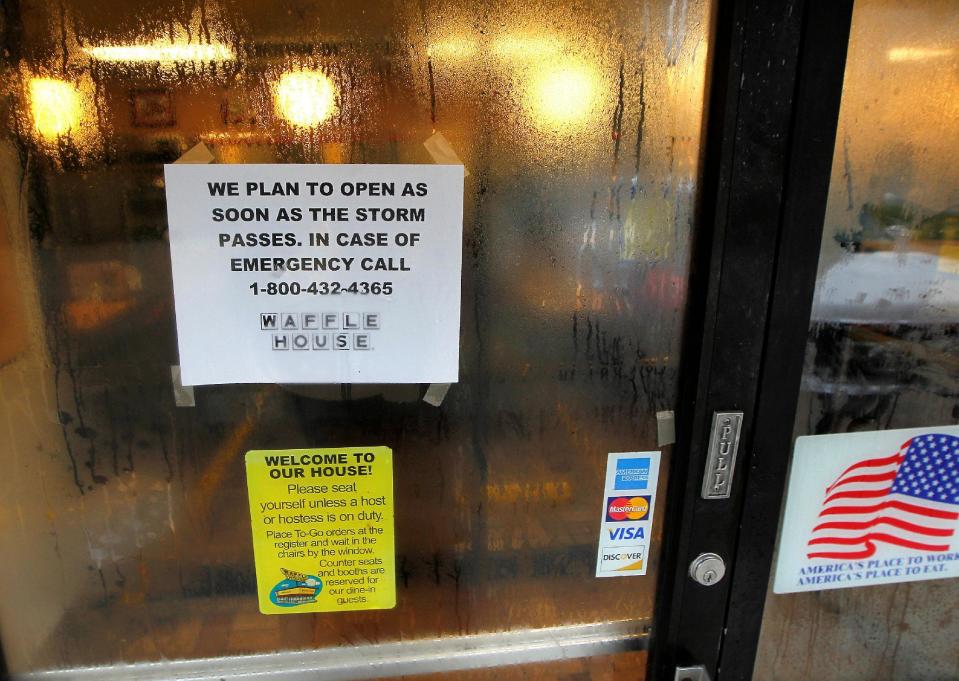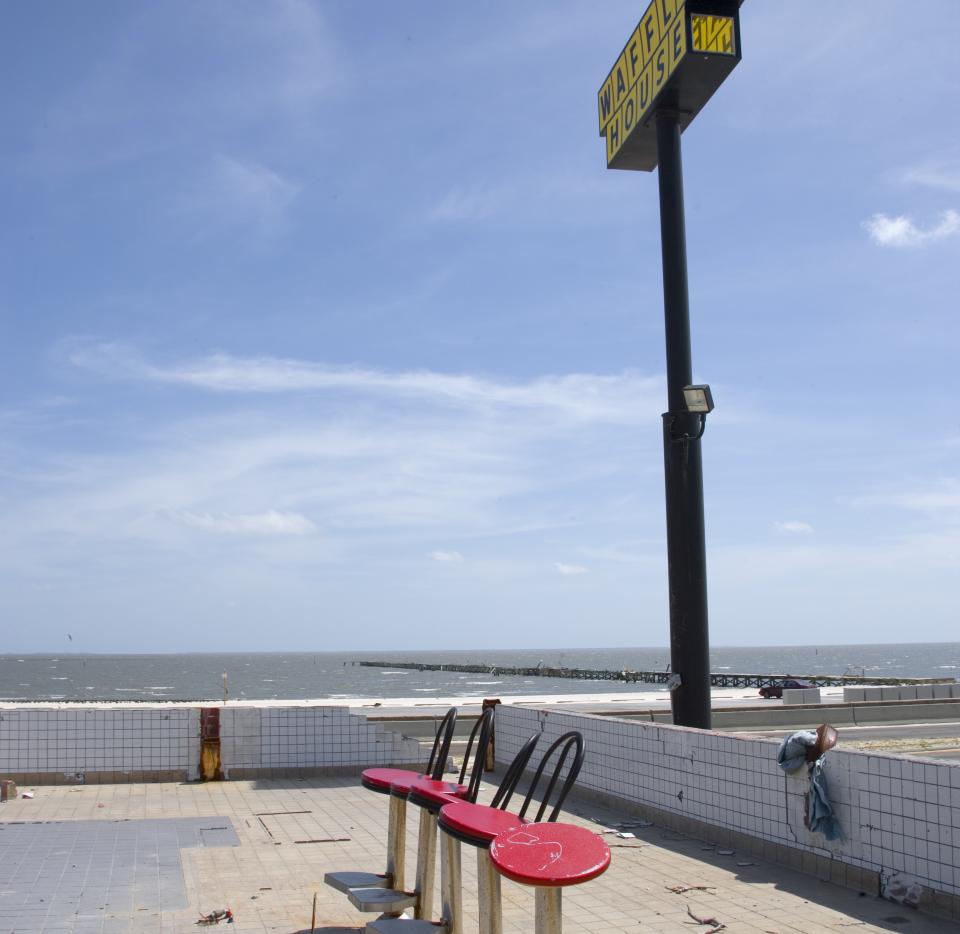How Waffle House's hurricane response team prepares for disaster
One of the ways the Federal Emergency Management Agency (FEMA) measures hurricane damage is by the Waffle House Index. Waffle House, a popular 24-hour fast food chain in the Southeast, has a unique ability to operate solely on gas if necessary, so a closed Waffle House is often tantamount to disaster.
And while we won’t know yet how Hurricane Harvey will fare on the index, the attitude at Waffle Houses across Texas has been calm. The company’s staff has been preparing for months.
“We have our own special disaster teams and generators waiting to be shipped,” said one Waffle House employee in Galveston, Tex. “We’re open up until the city makes us close, probably later on tonight. As soon as it’s over we’ll be right back open.”

Waffle House’s resiliency is a great source of satisfaction for people. The Galveston employee told Yahoo Finance proudly, “When nothing else is open I’m going to tell you the Waffle House is open.”
Over the years, FEMA administrator Craig Fugate noticed this phenomenon following hurricane damage and developed the Waffle House Index. “Green” is full menu, “yellow” is partial menu, and “red” means there may be no Waffle House left.
“Waffle House stays on when the wind’s blowing—they never close,” Philip Strouse, FEMA’s Private Sector Liaison, told Yahoo Finance last year. “They have a small footprint, they’re easy, and if these little stores are going out when it only takes a few people to staff … that’s bad.”
Preparing ‘jump teams’
Hurricane preparation for many can be a scramble, but for Waffle House, it’s a game of chess with military-style strategy and execution. Before a storm hits, and even before hurricane season, the company makes storm checklists for each location, meets with local authorities, and educates new employees, though many have been through 15 hurricanes.
“We’ve already done all that,” Waffle House’s director of external affairs Pat Warner told Yahoo Finance. “Right now we’re getting jump teams ready.”

A Waffle House jump team consists of a small team of restaurant operators from outside the hurricane zone. These employees swoop in at the first possible moment after a storm to restore service and get things open. Typically after a storm, demand for food is high and functioning restaurants are in low supply, and things get extremely busy.
“There’s a jump team outside of Nashville ready to go on Sunday. Jump teams are [also] ready in Louisiana,” said Warner. “Then we can deploy from the main office some teams that may or may not go depending on severity.”
One of the reasons why these jump teams are the key to the chain’s success is because employees may not be able to work if they’re dealing with their own hurricane damage.
“It does help to bring operators from outside so it relieves [local employees] so they can focus on family,,” said Warner. “They don’t have to worry about their restaurant at the same time.”
During Hurricane Katrina, Warner said Waffle House worked beyond its restaurants to provide temporary lodging for its workers, putting tarps on employees’ roofs and shipping in hard-to-find essentials like diapers and formula.
The day of the impact
On a day like Friday, when a hurricane is coming, Warner said the Waffle House team gets its jump teams into position to prepare for the worst.
“We’re on call, loading up our command center,” he said. ”Whether we roll or not we don’t know; we want to get together just in case.”
Waffle House doesn’t really operate in Corpus Christi, where the hurricane is expected to hit the hardest, but the flood-prone Galveston and Houston areas are filled with around 20 Waffle Houses.

“We’re all waiting to see what he’s gonna do after he comes on shore,” Warner said, referring to Harvey. “Right now it looks like we may have a Category 3… so we’re anticipating some damage to the restaurants.”
What a Waffle House needs to open
Like any restaurant, Waffle House needs food, employees, a safe location, and energy. In the planning process before a hurricane, Waffle House works with food distributor U.S. Foods (USFD) to make sure its shelves are stocked and its locations are prepared for possible supply-chain issues. The jump teams supply the labor.
The other elements can be more tricky, but Waffle House’s planning accounts for construction teams that are ready to go in if there are significant structural damage and power issues.
“Is it structurally safe, that’s number one,” said Warner. “If there’s even a doubt we’re not gonna open. After that it’s what utilities are there. This is all in our storm checklist, and we review it all the time.”
Energy-wise, not that much is needed, though food safety and IT professionals in the field are available to be dispatched quickly to locations to get things safe and online.
“If we have gas for the grills, we can open,” said Warner. “We tailor the menu for what we can cook. Obviously, without electricity we’re not gonna have waffles, but we can bring in water and porta potties. If we don’t have electricity we can bring in generators. We’ve had some cases that before the generator came, we were there with candle light.”

Getting a restaurant operational requires working closely with various federal and local agencies, so Waffle House’s response team keeps in close contact with FEMA and others.
“It’s nice to have that support too because we need information,” said Warner. “When’s the power gonna come back on? What about the water? It’s good to get that info quick to the folks in the field.”
Practice makes perfect
Katrina, not surprisingly, was the biggest storm Waffle House has dealt with. While not as bad, last year’s Hurricane Matthew spanned five states up and down the I-95 corridor, a vast area in which to respond. “We had over 200 people on jump teams that were spread out,” said Warner.
After each storm, the company analyzes its own response to improve its disaster deployment. “We learn something from every storm,” said Warner. “The prep gets you there and each storm is gonna be different. The flooding, the damage — there’s a lot of variables, then afterwards we take a step back.”
All of the complexity of the response prompts a question: Why? Part of it is because they can. With a somewhat simple menu and needs, they can do things others can’t. But Warner noted that the reputation that led former FEMA administrator Craig Fugate to create the Waffle House Index as a disaster indicator has given them a level of pride. It has also pressured them to double down on their efforts.
“It’s a mixed blessing to be recognized,” said Warner. “Now we have to live up to it.”
—
Ethan Wolff-Mann is a writer at Yahoo Finance focusing on consumer issues, tech, and personal finance. Follow him on Twitter @ewolffmann. Got a tip? Send it to[email protected].
Read More:
What Bitcoin needs to do to become real currency
Trump weighs slashing one of the most popular tax deductions
Big banks are going after Venmo and Venmo is winning
73% of Android users are less likely to switch to iPhone due to headphone jack
‘Market FOMO’ has millennials putting cash into the stock market
Sometimes fake holidays like ‘National Ice Cream Day’ actually work
A robot lawyer can fight your parking tickets and much more
Consumer watchdog is making it easier for consumers to sue banks